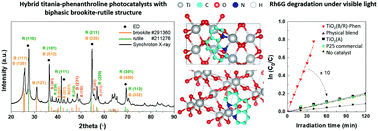The use of N^N ligands as an alternative strategy for the sol–gel synthesis of visible-light activated titanias†
Abstract
This work presents the first biphasic brookite–rutile organotitania, TiO2(B,R)–Phen, synthesized by a sol–gel method, under mild conditions and using 1,10-phenanthroline (Phen) as a crystal modifier and as a source of intermediate N2p states. Phen is able to coordinate to the Ti(IV) atom of the titanium alkoxide precursor, tetrabutyl orthotitanate (TBOT), forming an organotitania precursor that leads to the formation of a binary brookite–rutile structure, instead of the typical anatase. Different from the nitrogen-doped titanias, in which the N2p levels form due to the presence of N atoms in the O lattice position of the titania crystal, the coordination between the Ti atom of the titania precursor and Phen is maintained during the whole synthetic process, which is responsible for the presence of intermediate N2p states related to Ti–N bonds in the final materials, which is key to activating the photocatalysis behavior under visible light. Both features allow the simultaneous reduction of charge recombination rate and enhancement of photo-induced electron transfer in the visible range. Indeed, a 10-fold increase in the photocatalytic rate constant along with enhanced stability for the degradation of cationic dyes in aqueous solutions under visible light was noted in stark comparison with reference titanias. The photocatalysis mechanism consists of the self-degradation of the dyes, while the enhanced photoactivity results from a combination of the binary brookite–rutile structure and the blue absorption Ti–N states. As such, this work presents a unique synthesis strategy to obtain biphasic brookite–rutile organotitanias bearing Ti-N bonds that exhibit superior photocatalytic degradation activity of pollutants in aqueous solutions using visible light.



 Please wait while we load your content...
Please wait while we load your content...